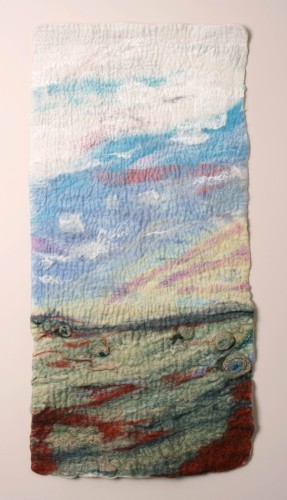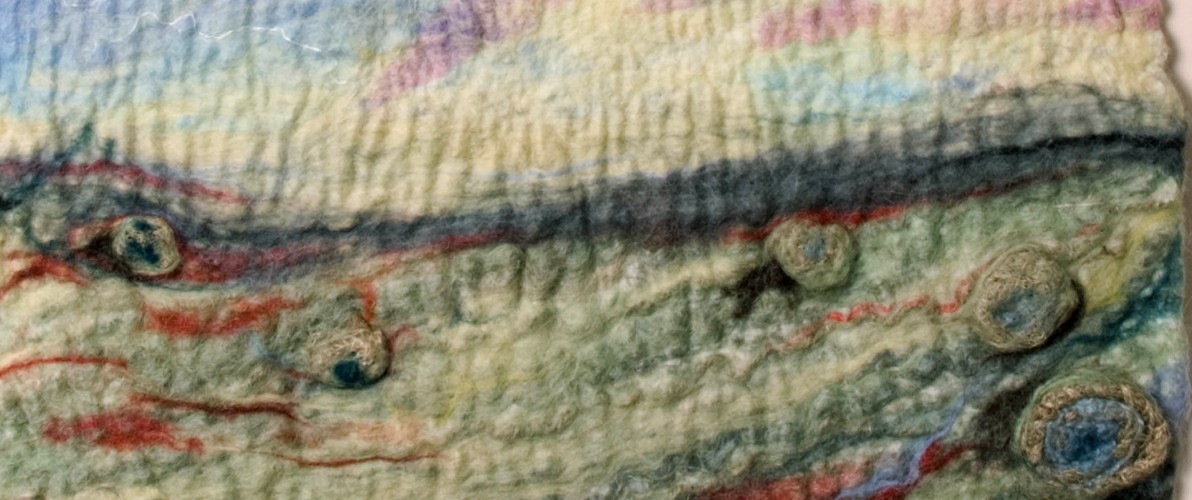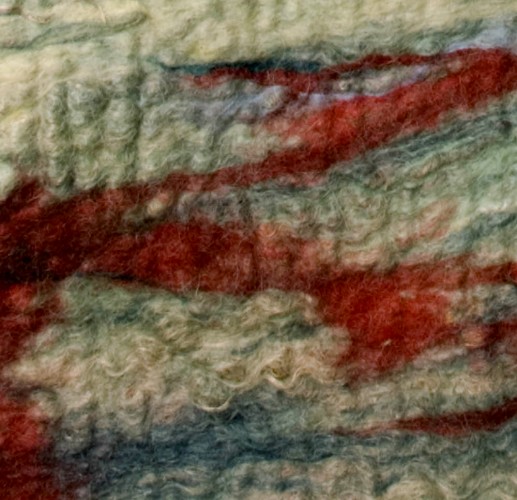Design idea
The production of a textural felt hanging, which allows the exploration of sensory distortion and dysfunction by tactile means. Incorporating new and recycled materials, together with animal and plant fibres and felting techniques.
Materials
Jute batt and merino carded together, Shetland, BFL, Gotland, Ramie (lustrous vegetable fibre – soft, strong, smooth and durable), Organza, Viscose Tops, Luffa, Jute sack seams and Calico.
Process and Evaluation
Carded jute and merino wool, two layers are used to form a substrate on which a dye painted sheet of muslin has been laid. Lightly weft-stitched bonded strips of waste cellophane, yarn made from jute, hemp and wild silk are woven and integrated with merino and ramie fibres to form patches which are also stitched onto the muslin. The patches represent a range of sensory sensations and the process of shrinking adds a variety of shapes, leaving the felt looking smooth but feeling very different.
Control by hand felting allows shrinkage of approximately 20%. The direction of felting applied will enable the length to be retained whilst the width is reduced, creating undulating ridges. The hanging exemplifies a merging of plant and animal fibres. It will be handled, and consequently there is a need to ensure that the piece is well felted and robust.
The jute has felted well with the wool and I feel that I have been more conservative with the jute than originally envisaged. The jute has a silky texture, high tensile strength, is resistant to heat and fire and can be dyed using reactive dyes. The plain woven jute string has provided the desired rough and hairy patches. One weaving has straight lines and the other is more ragged and curly. Small sections of hemp, which are smooth and have a darker hue, have been used throughout the piece, adding contrast, whilst the use of ramie adds silky bright highlights.
The red Shetland wool, red cellophane and red metallic threads engage the eye, generating impact and movement. The cellophane creates highlights, bubble texture and crinkle noise. The red metallic thread was intended to enliven the matt of the Shetland, but some impact has been lost during the felting process. The fine metallic pink boucle yarn woven patch has also merged with the merino fibres leaving lighter highlights above the reds.
Darker fibres used in the lower section have been selected to add weight and to emphasise the bumpy texture created by the shrinkage of the wool against the muslin. The colour painted on to the muslin creates depth. Browns, blues with red and green accents add variation and emphasis drawing the eye downwards and away from the intense red. White, grey and red link the whole felt, and a tonal range is used in red to avoid a sense of uniformity. The variation is intended to challenge, and to make the viewer want to touch and understand the work. The lower part of the felt is ragged and this imparts a sense if elongation.
The light reflects on this piece throughout the day and changes my impression of this work. I have enjoyed producing what is a very different work from previous felts, and I shall continue to use plant fibres. I have discovered a real affinity with the hairy, unfinished appearance of this piece which I find preferable to the smoother, more craftsman-like work of earlier exhibition work.
The felt will be loosely hung, leaving space behind to allow the viewer to feel and discover the different textures. Creating shadow and highlighting the negative space behind the felt spotlights creates impact.
Extracted from 2010 files


